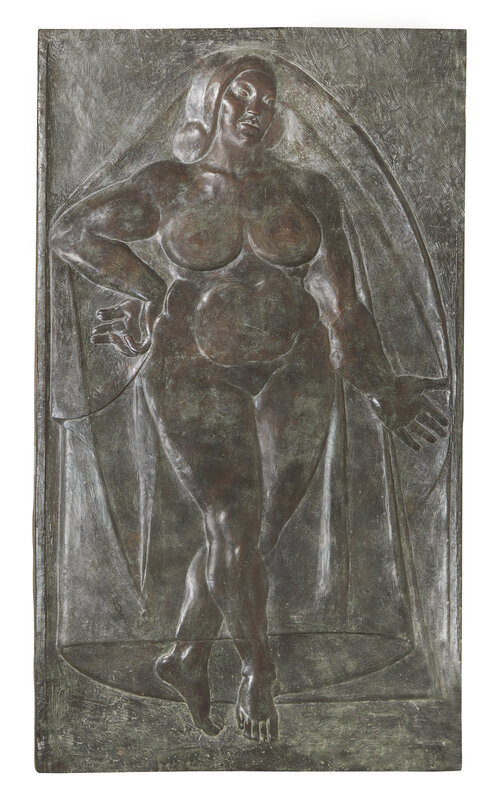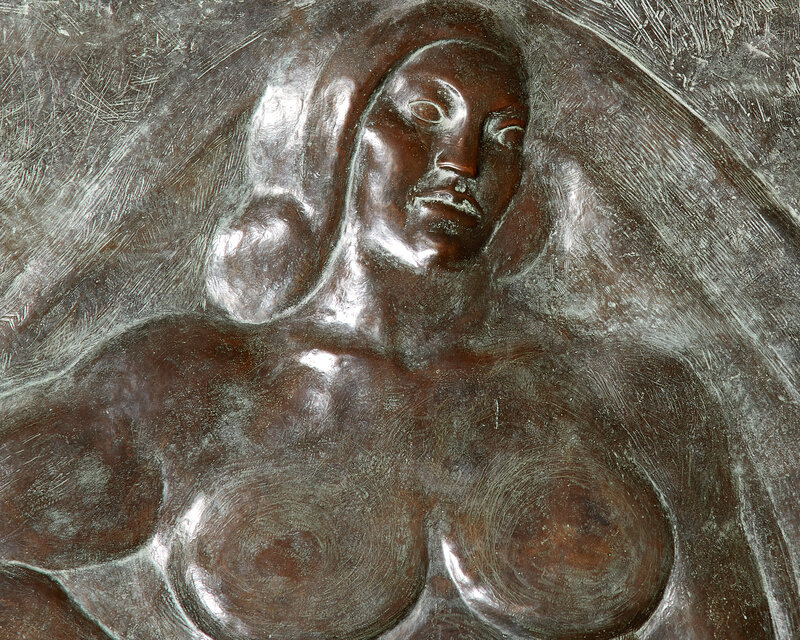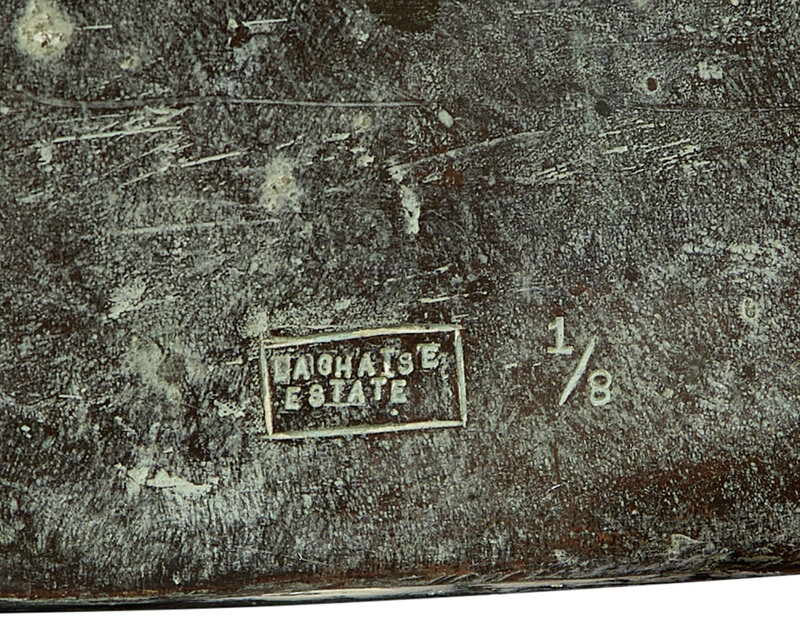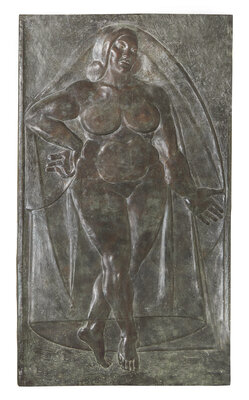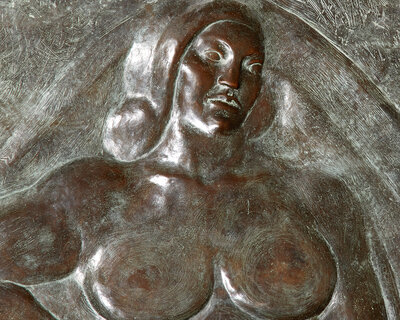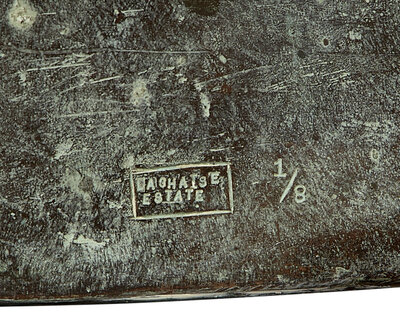Condition Report
Contact Information
Auction Specialist
Lot 85
Gaston Lachaise
(American/French, 1882-1935)
Relief-Woman (Second State) [LF 128], 1934
Sale 2105 - American Art and Pennsylvania Impressionists
Dec 8, 2024
2:00PM ET
Live / Philadelphia
Own a similar item?
Estimate
$120,000 -
180,000
Lot Description
Gaston Lachaise
(American/French, 1882-1935)
Relief-Woman (Second State) [LF 128], 1934
bronze with brown verdigris patina
stamped LACHAISE/ESTATE and numbered 1/8 (lower right), modeled in 1934, this example cast in 1975
height: 86 in.
Property from a Private New York City Family Collection.
We wish to thank Virginia Budny, author of the forthcoming catalogue raisonné of Lachaise’s work (sponsored by the Lachaise Foundation), for her assistance in preparing the catalogue entry for the present work.
Provenance:
Lachaise Foundation, Boston, Massachusetts.
Robert Schoelkopf Gallery, New York, New York.
Acquired directly from the above, October 1975.
Private Collection, New York.
By descent in the family to the present owner.
Exhibited:
Greenvale, Long Island, New York, Long Island University, C. W. Post Art Gallery, The Long Island Art Collectors’ Exhibition: Modern Masterpieces and Contemporary Art from Long Island Art Collections, October 24 - November 23, 1975, n.p., referenced.
Literature:
The Museum of Modern Art, Gaston Lachaise: Retrospective Exhibition, an exhibition catalogue, New York, 1935, p. 28, no. 58 (plaster model illustrated).
Winslow Ames, “Gaston Lachaise, 1882-1935,” Parnassus, vol. 8, no. 4, April 1936, p. 41 (plaster model referenced).
Robert Schoelkopf Gallery, Gaston Lachaise: Sculpture and Drawings, an exhibition catalogue, New York, 1973, n.p. (plaster model illustrated as Woman).
Advertisement, Robert Schoelkopf Gallery, Art in America, vol. 62, no. 3, May/June 1974, p. 100 (plaster model illustrated).
Gerald Nordland, Gaston Lachaise: The Man and His Work, New York, 1974, p. 125, 126, fig. 63 (plaster model illustrated).
Salander-O’Reilly Galleries, Gaston Lachaise (1882–1935): The Monumental Sculpture, an exhibition catalogue, New York, 1994, no. 4 (model incorrectly dated c. 1930-1936, another example illustrated as Bas Relief Woman).
Anne Barclay Morgan, “Gaston Lachaise: The Monumental Sculpture,” American Art Review, vol. 7, no. 5, October/November 1995, p. 120 (another example illustrated).
Salander-O’Reilly Galleries, Gaston Lachaise [1882–1935]: Reliefs, an exhibition catalogue, New York, 1999, n.p., no. 8 (another example illustrated as Bas Relief Woman).
Deborah Emont Scott, Martin L. Friedman, Modern Sculpture at the Nelson-Atkins Museum of Art: An Anniversary Celebration, Kansas City, Missouri, 1999, p. 11 (another example illustrated as Bas Relief Woman).
Art + Architecture: The Ebsworth Collection + Residence, San Francisco, 2006, n.p. (another example illustrated).
Nelson-Atkins Museum of Art: A Handbook of the Collection, Kansas City, Missouri, 2008, p. 180, fig. 82 (another example illustrated as Bas-Relief Woman).
Gerald Peters Gallery, Gaston Lachaise: A Modern Epic Vision, Santa Fe, 2012, pl. 35 (another example illustrated as Relief (Woman) [LF 128]).
Virginia Budny, Gaston Lachaise: For the Love of Woman, an exhibition catalogue, New York, 2016, pp. 8, 10-11, 38-40, fig. 14 (interior of waste mold of the first state of the relief illustrated; Lachaise’s drawing of his projected revisions on a photograph of the interior of the waste mold illustrated; another example illustrated (as Figure of a Woman [Relief-Woman]) [LF 128]).
Lot Essay:
Gaston Lachaise’s large Relief-Woman [LF 128], which represents an open-handed, inviting, goddess-like nude resembling his wife, Isabel Duteau (or Dutaud) (1872-1957), was developed in two distinct, well-documented stages, the first in 1925 and the second in 1934. Having created the first stage of the full-scale model before the fall of 1925, he considered that version to be unfinished and expressed his intention to cast the model in bronze when it was completed. He likely envisioned the large relief as a decorative architectural element comparable to the 68-inch-tall reliefs of winged nude personifications of the Four Seasons, for the exterior of Welles Bosworth’s residence in Matinecock, Long Island, that he had carried out two years earlier. Lachaise’s Relief-Woman is the first heroic relief that he himself initiated, with the aim of finding a suitable buyer. He likely envisioned the work as a way to express, in the elevated language of those reliefs, his wife’s notable hospitality and generosity in the form of the serene, middle-aged nude.
Lachaise created the plaster model for the first stage of the low relief by carving the composition into a painted slab of plaster. The nude at this stage of the relief exhibits the idiosyncratic, mature figure type that he had introduced to the public in his first exhibition, in 1918, and that was ultimately both inspired by Isabel’s voluptuous body and disciplined by an implicit geometry. The substantial nude in this first version of the relief advances on tiptoes (signifying her elevated state), her head slightly tilted to the side (indicating receptivity), her right arm akimbo (indicating steadfastness), her left arm and hand extended in a warm, welcoming gesture, and her body framed by voluminous drapery.
In 1934, Lachaise again worked on the relief. On August 3, he wrote to his wife: “I have begun to work again—nearly finished the bas relief—the large one in plaster—It’s definitely turning into a good thing—tranquil and generous” (Gaston Lachaise Collection, Yale Collection of American Literature, Beinecke Rare Book and Manuscript Library). In the final version of the relief [LF 128], the arrangement of the woman’s hair is fuller; her body is even more robust than in the first version (reflecting the treatment of ideal nudes he introduced in 1928-1930); her large hands are given even greater importance; and the drapery is more plentiful. In these ways, the original nude has been endowed with an impressive monumentality, in what is almost an apotheosis. The result is an altogether more expansive and masterful composition.
The second state of the relief was first cast in bronze after the Lachaise Foundation, established in 1963, issued a projected edition of eight numbered Estate bronze casts. Five, including the present example (the first), were made for the Foundation between 1975 and 2012 by the Modern Art Foundry, New York. The second (1993) is owned by the Nelson-Atkins Museum of Art, Kansas City, Missouri. And the fourth (2003) is owned by Museum of Fine Arts, Boston. The sixth (2012), selectively gilt, is owned by the Lachaise Foundation.
